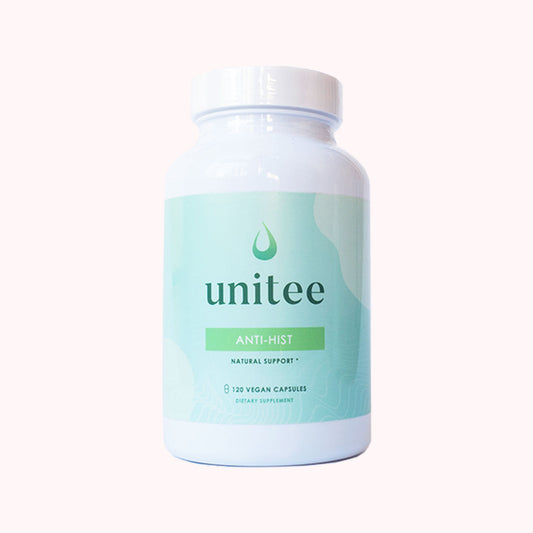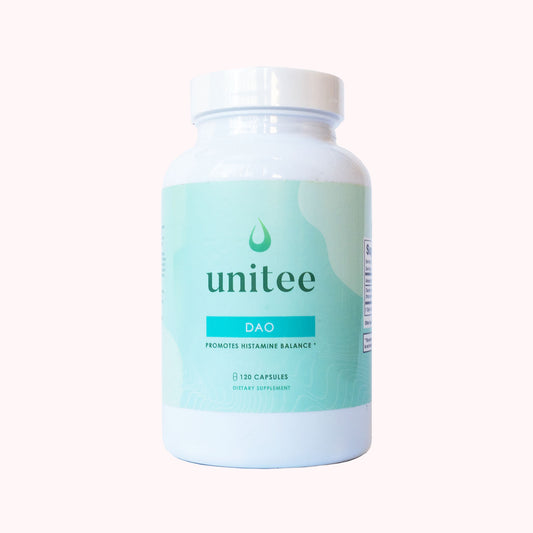Is there a test for histamine intolerance?
If you believe you are histamine intolerant and are looking for a histamine intolerance test, we need to talk.
Histamine intolerance can be frustrating, as there is a lack of understanding and recognition among healthcare practitioners when it comes to this disorder.
Additionally, the nature of the disorder involves a wide range of seemingly unrelated symptoms, making it difficult to diagnose and control.
However, as your histamine intolerance expert, I've got you covered.
I've done the digging and today, I propose that a careful, evidence-based analysis of what is shown in the literature allows us to define a systematic approach to understand the physiological contributions to each individual’s experience.
This understanding, under the guidance of an experienced practitioner, can lead to a diagnosis of histamine intolerance and control of symptoms.
What is Histamine Intolerance?
Histamine is a natural chemical that acts as a messenger in many body systems including but, not limited to the brain, the stomach, blood vessels and muscles.
Historically, it was characterized as our first chemical of defence released by cells in response to foreign pathogens. It also mediates the allergic reaction and can act as a messenger within the nervous system.
Histamine is pre-formed and stored in granules in several different cell types. These cells are widely distributed throughout the body. Several mechanisms including both allergic and non-allergic pathways can stimulate these cells to release histamine. The histamine then binds to a number of receptors to exert its effects.
Due to the wide distribution of histamine producing cells and the equally wide distribution of histamine receptors, the effects of receptor binding involve many organ systems.
Resulting symptoms may therefore be spread across the body and include flushing and rashes (skin), arrhythmias, low blood pressure or dizziness (cardiovascular system) and nausea, vomiting, diarrhea, abdominal pain (gastrointestinal system), to list a few (1). For a comprehensive list, see this post on histamine intolerance symptoms.
So, in summary, we have a chemical molecule produced in many cells and released following any of a multitude of stimuli and acting on any number of organs.
No wonder the effects are inconsistent from patient to patient and case to case and no wonder you are confused by your symptoms.
Histamine Intolerance Testing
The added complexity of creating a test for histamine intolerance is one of context.
Each individual will have a tolerance level beyond which they develop symptoms. We can, therefore, define histamine intolerance as a state where the physiological histamine level exceeds an individual’s tolerance level i.e. the level beyond which they begin to develop symptoms.
What contributes to this tolerance level?
Again, this is determined by a multitude of factors. This level may be genetically predetermined. It may be a result of other chemical messengers such as hormone levels, individual variances in diet or the simultaneous use of certain medications. Each case can vary.
Furthermore, other physiological states such as inflammatory conditions of the gastrointestinal tract may contribute to histamine tolerance. So, not only are the effects of histamine widespread, the extent of the effect will vary from patient to patient and case to case.
In any case, the ultimate issue of intolerance is an elevation in histamine concentration. Such elevations in histamine result from an imbalance in histamine levels versus histamine breakdown or, what can be described as a dysfunctional histamine metabolism (2).
Histamine levels, from any source, may rise and, when the individual's ability to break down the histamine is compromised, the balance tips towards histamine excess and adverse events are triggered.
So, now that we know what histamine intolerance is, how do we know if that's the main issue causing or contributing to your symptoms?
Blood Tests for Histamine Intolerance: Do they Work?
Blood testing is a quick and minimally invasive way of checking for levels of histamine or diamine oxidase enzymes.
These tests actually can be useful in some cases as they can give a clue something is going wrong. However, they can miss an overwhelming amount of information when it comes to histamine intolerance and therefore, the markers cannot be fully relied upon for diagnosing histamine intolerance.
The reason for this is because the underlying nature of histamine intolerance is multi-faceted.
You see, your histamine levels may be normal depending on what you've eaten, time of day you've tested, if there's no other immune activation and a variety of other factors.
However, you could lack the amount of diamine oxidase enzymes necessary to appropriately breakdown histamine, for example.
In this case, you could get a result where histamine levels are completely normal on that given day, however... after a few meals of consuming histamine-containing foods, your histamine levels could be out of control by that same evening, while having a lack of enzymes to appropriately break dow that histamine.
So then what...well, we can also test for diamine oxidase enzyme levels. So, why wouldn't this fix things?
Well, diamine oxidase enzymes are not the only enzymes responsible for degrading histamine. Additionally, if you have a separate underlying issue such as mast cell activation syndrome or bacterial overproduction of histamine, then a result of adequate diamine oxidase levels may present seemingly normal results while a histamine intolerance is still present.
Add that to the issue above of high histamine levels being transient and symptoms also being dependent upon other factors of production and breakdown, you're really not going to get an accurate results and it could be very easy to miss histamine intolerance.
Now, if your histamine levels are off the charts and your diamine oxidase enzyme levels are super low, yes, this can provide valuable info - however, these cases are only a small part of the puzzle of histamine diagnostics and, as mentioned, if you measure at the wrong time or don't have these specific factors at play during your test, then it's very easy to get a false negative.
So, what's next?
To be honest, one of the best methods we have right now is trial and error self-testing. The reason this can be so helpful is because you can actually try a combination of histamine lowering factors (ie. a histamine lowering diet and supplements that decrease histamine levels) and see if that improves your symptoms.
As these interventions target histamine specifically, elimination of histamine and subsequent symptomatic improvement is a much more powerful indicator of the presence of a histamine intolerance than simply relying on a blood test which, regarding histamine, is a snapshot of your body's status at that moment in time.
So, let's get to discussing an at-home test I created through my experience of being histamine intolerant, working with histamine intolerant clients and doing plenty of scientific research to see what can and cannot help.
I call this test Tee's Histanalysis Method.
A Test for Histamine Intolerance: Tee's Histanalysis Method
By sifting through the relevant literature and identifying where there is sufficient evidence, I have defined an approach to an at-home histamine intolerance test called Tee's Histanalysis Method.
This test for histamine intolerance is focused on identifying contributions to an individual’s histamine excess. The order of testing should be informed by the individuals symptoms and the physiological environment. It is highly recommended that this histamine intolerance test is guided by a practitioner with the relevant experience in interpreting the results.
Histamine Intolerance Test Steps:
1. The first step of applying a test for histamine intolerance is to record all of your symptoms and suspected contributors, including food products and medications. Compare these suspects to known high histamine foods and medications. Remember, you may have additional intolerances, so not all suspected foods must be high in histamine. But, all high histamine foods should be a suspect when consumed in excess.
2. The second step of the histamine intolerance test is dietary elimination of suspected foods (12). This elimination includes applying a low histamine diet along with any additional suspected offenders. Use this histamine intolerance food list, as it contains high histamine foods along with foods that may not be high in histamine themselves but, can act as histamine releasers or encourage bacterial production of histamine.
3. The next thing you'll want to do when conducting a test for histamine intolerance is record all changes between your food and symptoms. Do this by keeping a food/symptom diary and include all necessary details including exercise, stress levels, supplements, etc. I've created a useful template for this that will ensure you're entering all of the necessary information. You should use this food diary template and fill it in after each meal.
4. After two weeks of following the specific diet above, incorporate a DAO enzyme supplement into your daily routine. This will begin to raise your DAO enzyme levels to break down the histamine in your body faster. You may notice an improvement within just a few days.
5. After 5 days of incorporating DAO enzymes, begin to add in a take a loading dose of Anti-Hist, alongside the DAO enzymes. The loading dose of Anti-Hist consists of taking 2 capsules three times per day for 7-10 days. Be sure to order both of these in advance, so that you have them on hand when it's time to start taking it. You can get them in a discounted DAO & Anti-Hist Bundle to have for this test.
6. Following the loading dose, drop the dosage of Anti-Hist to a maintenance dose of between 1-3 capsules per day as needed to maintain improvements. Many are fine with one capsule per day but, if your improvements are not sustained, you may take one capsule before each main meal. Continue taking the DAO enzymes as normal.
7. Review your food/symptom diary and begin replicating the days where your symptoms were rated to be at their mildest. Include the same foods, exercises, supplements and DAO enzyme and Anti-Hist dosage in this replication.
Your food diary will also give you insight into which supplement (or both) helped more. This is why we have a waiting period between introducing these. If you felt an improvement after DAO but not after Anti-Hist, your underlying cause is likely pointing to DAO enzyme deficiency. If you did not feel much change after DAO but felt better after Anti-Hist, you likely have a mast cell stabilization issue. And, if you felt good after DAO but even better after being on both, you likely have issues with low DAO enzymes and mast cell instability.
This will not only give strong clues for the underlying cause, but also point you towards what supplements will work best for you to be taking in the long-run.
8. Once you've reached a stable state where your replicated days are consistently producing mild levels of symptoms, begin reintroducing foods at a rate of one food consumed for 2-3 days, with a 5 day break in between foods. Consuming the food for 2-3 days allows for enough to be consumed that a reaction will occur if you are sensitive. If you experience a reaction earlier, you can stop consuming the food immediately. Additionally, the break between introducing new foods allows you to identify delayed reactions, as food sensitivity symptoms can appear up to 5 days after consuming the suspected food.
9. All foods which caused symptoms during reintroduction should remain eliminated from the diet. You may attempt a second reintroduction of the offending food after 3 months of following a histamine intolerance protocol, if desired.
As you can see, this simple at-home test for histamine intolerance is way more cost-effective than any other test out there - and, it can be more definitive, informative and result in immediate symptom reduction.
The logic behind this histamine intolerance test is that it can either help to rule out or reveal histamine intolerance. Simply put, no change in symptoms likely means you can rule out histamine intolerance, whereas immediate symptom reduction is a pretty strong indicator towards the presence of histamine intolerance.
As this histamine intolerance test can be done at home and only requires the cost of supplements, I recommend it as a more logical and cost-effective choice compared to many alternative tests or randomly selecting supplements which may only leave you with slight clues at a higher cost.
Evaluate the probability that you have histamine intolerance and, depending on the results, either start fixing it or stop wasting your time on it.
Getting Started With a Low Histamine Approach: What You’ll Need
- Histamine intolerance food list
- Food diary template
- Anti-Hist & DAO Bundle
- Histamine intolerance protocol (upon confirmation of the probability of intolerance)
I recommend starting this test as soon as possible in order to prevent the progression and worsening of symptoms, as well as preventing the harmful impact on other body systems which makes the disorder more difficult to address.
There is no reason you can't begin today by starting your food diary and following the first steps of the protocol, which you can access immediately for free by clicking below.
References:
- Maintz L, Novak N. Histamine and histamine intolerance. Am J Clin Nutr. 2007;85(5):1185–96.
- Schwelberger HG. Histamine intolerance: A metabolic disease? Inflamm Res. 2010;59(Suppl 2):S219-21.
- Schwab D, Eg H, Raithel M. Histamine content and histamine secretion of the colonic mucosa in patients with collagenous colitis. Inflamm Res. 2002;51(1):33–4.
- Reese I, Ballmer-Weber B, Beyer K, et al. German guideline for the management of adverse reactions to ingested histamine: Guideline of the German Society for Allergology and Clinical Immunology (DGAKI), the German Society for Pediatric Allergology and Environmental Medicine (GPA), the German Association of Allergologists (AeDA), and the Swiss Society for Allergology and Immunology (SGAI). Allergo J Int. 2017;26(2):72-79. doi:10.1007/s40629-017-0011-5
- Wöhrl S, Hemmer W, Focke M, Rappersberger K, Jarisch R. Histamine intolerance-like symptoms in healthy volunteers after oral provocation with liquid histamine. Allergy Asthma Proc. 2004;
- Giera B, Straube S, Konturek P, Hahn EG, Raithel M. Plasma histamine levels and symptoms in double blind placebo controlled histamine provocation. In: Inflammation Research. 2008.
- Kanki M, Yoda T, Tsukamoto T, Shibata T. Klebsiella pneumoniae Produces No Histamine: Raoultella planticola and Raoultella ornithinolytica Strains Are Histamine Producers. Appl Environ Microbiol. 2002;68(7):3462–6.
- Maintz L, Benfadal S, Allam JP, Hagemann T, Fimmers R, Novak N. Evidence for a reduced histamine degradation capacity in a subgroup of patients with atopic eczema. J Allergy Clin Immunol. 2006;
- Pinzer TC, Tietz E, Waldmann E, Schink M, Neurath MF, Zopf Y. Circadian profiling reveals higher histamine plasma levels and lower diamine oxidase serum activities in 24% of patients with suspected histamine intolerance compared to food allergy and controls. Allergy. 2017;
- Music E, Silar M, Korosec P, Kosnik M, Rijavec M. Serum diamine oxidase (DAO) activity as a diagnostic test for histamine intolerance. Clin Transl Allergy [Internet]. 2011;1:P115. Available from: www.biomedcentral.com/submit
- Manzotti G, Breda D, Di Gioacchino M, Burastero SE. Serum diamine oxidase activity in patients with histamine intolerance. Int J Immunopathol Pharmacol. 2016;29(1):105–11.

Anita Tee
My name is Anita Tee. I'm a nutritional scientist who specializes in histamine intolerance. I hold a Master of Science in Personalized Nutrition and a Bachelor of Science in Human Biology and Psychology. For the past ten years, I have used my experience in nutritional and medical health sciences to create a scientifically backed, natural approach to healthcare that relies 100% on evidence-based research. As I previously suffered from - and overcame - histamine intolerance, my focus is to increase recognition and expand the available resources and protocols available for resolving this particular disorder. To date, I have helped over 4,000 individuals fully resolve or better manage their histamine intolerance symptoms.







